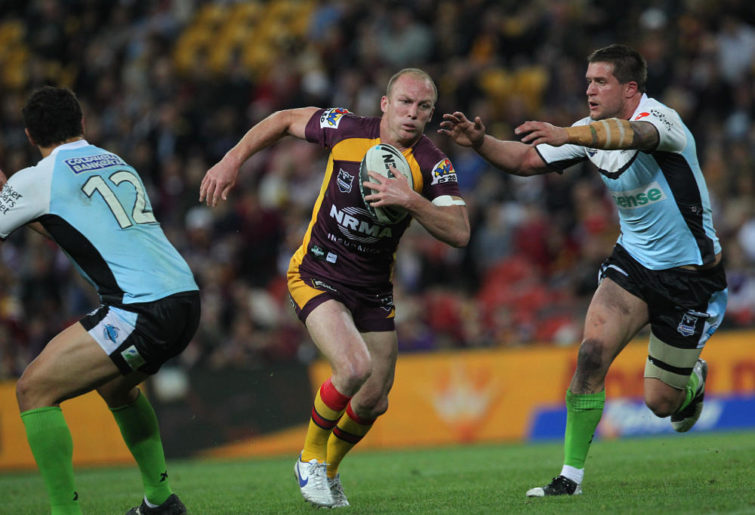Chooks stun THEMSELVES after containing entire Dragons set inside 10m line, scoring ridiculous try
The Roosters won 60-18 with this incredible sequence capping off the performance.
Opinion
A quality ‘spine’ in rugby league has become a sought-after commodity and the highest common denominator to success in the NRL.
However, when considering the importance of a quality fullback, hooker, halfback and five-eighth, the latter is the one that more often than not gets neglected on the scale of influence.
As the name suggests, the traditional role of the five-eighth is the go between the halfback and the three-quarters, using a combination of vision and skill to distribute the ball from the congested middle field to the fleet-footed outside backs.
The luxury of being positioned on the outer fringes of the ruck allows the five-eighth to decide whether the best option is to pass to those outside, or take advantage of spaces created by the halfback and the go-forward of the middle-men.
With options at their disposal and control as to how a sides attacking weapons receive the ball, the role of the No.6 should not be underestimated.
When one thinks of some of the great five-eigths of the preceding 40 years, it doesn’t take long to gather a long list of individuals who dominated the game. Wally Lewis, Brett Kenny, Terry Lamb, Laurie Daley, Brad Fittler and Darren Lockyer, just to name a few.
One of them already an Immortal, with the others well in the conversation for such an honour, any of these names would be automatic selections in any modern-day spine.

Digital image by Colin Whelan © nrlphotos.com
Although varied in physical stature, it was the ability of these players to know when to take the line on or shift the ball sideways that made them great. It is different to the attacking mindset of a halfback, who has the luxury of isolating tired middle forwards, who on large do not move laterally as well as those closer to the fringes.
Fulfilling this role on both sides of the field ensured the development of a long and short passing game without rival. With a good one possessing the complete bag of tricks, quality five-eighth play is an art form, imperative to team success.
However, it’s an art form that is often lost in the modern game. Attacking structures introduced in the early 2000s have restricted both the halfback and five-eighth to one side of the field each. Rather than specialist positions, the collective term of ‘halves’ is used to describe the middle spine players.
This structure and lack of differentiation has stifled the development of the skills that made the five-eighth such an important attacking weapon in any rugby league side.
The mechanical nature of the halves, and inability to break away from structure or ‘play what’s in front of them’ has significantly contributed to the lack of individualism and attacking creativity, especially amongst the teams in the bottom half of the premiership ladder.
This, in turn, leads to the aesthetically poor, predicable block plays that seem to be the only ammunition against the ironclad defence deployed in the modern game. In the majority of cases this onslaught is not enough to chink the armour.
It also restricts the skillset of a pure five-eighth, who is adept at making decisions two passes clear of the ruck, rather than in the hustle and bustle of the middle.
Not all have forgotten and dismissed the role and importance of the art of five-eighth play. In teams subject to recent premiership success, glimpses of the forgotten arts remain alive in those who wear the 6 jersey.
The unpredictability and dynamic running of Cameron Munster, and to a lesser extent, Jarome Luai have been instrumental in the success of Melbourne and Penrith.
Jack Wighton and Luke Keary should be added to the list of players that look completely at home playing two passes wide.

(Photo by Albert Perez/Getty Images)
As Roosters coach Trent Robinson attests, “There is importance in a number and the side of the field, but there is also importance in the player’s individual style of play and how they can play and what to play.”
It must be acknowledged that all of these men primarily play on one side of the field as per their preference. But it is their ability to play direct, unstructured, yet precise, football wide of the ruck that makes them outstanding contributors to their attacking prowess.
On the rare occasion they switch to the opposite side of the field, their ability to influence the game is amplified.
As with the former greats, their physical stature is varied, and not a precursor for success. What is of importance is the ability to make decisions on the fringes of the edge. Camping on one side of the field limits these opportunities.
This is no more evident than during South Sydney’s premiership campaign, and the contribution of Cody Walker.
Skilfully brilliant in his own right, criticism of Walker often surrounds his involvement in the game, especially in the critical moments. This lack of involvement can be readily neutralised by limiting the tendency to stay camped on his favoured left-hand side.
Imagine telling King Wally which side of the field he could play on?
Breaking away from this structure is integral to the recipe of success. Not only does it provide an unpredictability in attack, it allows the pure No.6 to play to their strengths.
It is not so much a revolutionary way of thinking, but a recalibration of why the five-eihgth is such an integral position to every rugby league team.
It is time for coaches to embrace the art of the five-eighth and let them remind us why they are equally important as the other members of the spine.